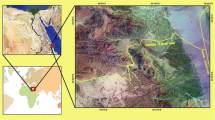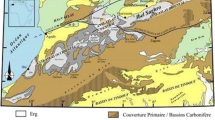Abstract
The advancement of geophysical methods and remote-sensing techniques, with improved processing models in recent years, encourage for further applied research in gold exploration and other associated elements and becoming useful tools for the exploration of new occurrences. The main objective of this research paper is to explore and map the hydrothermal alteration zones associated with gold mineralization in the Hamash area based on airborne geophysical (aeromagnetic and airborne gamma-ray spectrometry) and ASTER remote sensing data. For this purpose, ASTER and geophysical data are processed by different techniques including band ratios, minimum noise fraction, Crosta techniques, constrained energy minimization and F-parameter maps which allow for discriminating different rock units and delineating hydrothermal alteration zones. Furthermore, structural lineaments of surface and shallow-seated are effectively extracted and auto-mapped using ASTER and magnetic data. The potential mineral favourability map consists of F-parameter, interpreted structural lineaments, MNF, band ratio (4/8, 4/2, and 8/9), Crosta technique and CEM maps are combined through GIS model, by the application of fuzzy overlay analysis. This enabled to locate and map the areas of maximum potentiality of mineral favourability sites that occur in central and north-eastern parts within the Hamash area.




















Similar content being viewed by others
References
Abdelkareem M, Akrby A, Mousa Fakhry MM (2018) Using of Remote Sensing and Aeromagnetic Data for Predicting Potential Areas of Hydrothermal Mineral Deposits in the Central East-ern Desert of Egypt. Remote Sens 7(1):1
Aboelkhair H, Ninomiya Y, Watanabe Y, Sato I (2010) Processing and interpretation of ASTER TIR data for mapping of rare-metal-enriched albite granitoids in the Central Eastern Desert of Egypt. J Afr Earth Sci 58(1):141–151
Aboelkhair H, Hasan E, Sehsah H (2014) Mapping of structurally controlled uranium mineralization in Kadabora granite, Central Eastern Desert, Egypt using remote sensing and gamma ray spectrometry data. The Open Geology Journal 8(1):54–68
Aboelkhair H, Embaby AA, Mesalam M (2020) Contribution of ASTER-TIR indices with geophysical and geospatial data for groundwater prospecting in El-Qaa plain area, Southern Sinai, Egypt. Arab J Geosci 13(21):1–13
Abou El-Magd I, Mohy H, Basta F (2014) Application of remote sensing for gold exploration in the Fawakhir area. Central Eastern Desert of Egypt, Arab J Geosci, DOI 8:3523–3536. https://doi.org/10.1007/s12517-014-1429-4
Aero-Service (1984). Final operational report of airborne magnetic / radiation survey in the Eastern Desert, Egypt. For the Egyptian General Petroleum Corporation (EGPC), Cairo, Egypt, Aero-Service, Western Geophysical Co. of America, Houston.Texas, USA, six volumes
Ammar AA, El Sirafe AM, El Kattan EM (1993) Airborne geochemical and structural investigation of the Precambrian copper-bearing rocks, Hammash District, South Eastern Desert. Egypt Annal of the Geol Surv Egypt 19:467–486
An P, Moon WM, Rencz A (1991) Application of fuzzy set theory for integration of geological, geophysical, and remote sensing data. Can J Explor Geophys 27(1):1–11
Beucher A, Fröjdö S, Österholm P, Martinkauppi A, Edén P (2014) Fuzzy logic for acid sulfate soil mapping: application to the southern part of the Finnish coastal areas. Geoderma 226:21–30
Bishta AZ, Soliyman MA, Madani AA, Abu Qudai MA (2010) Utilization of lineaments extraction from satellite imageries in structural mapping and mineral exploration of Central Wadi Araba, Southwest Jordan. Earth Sci 21(2):1–27
Boardman J W, Kruse F A, & Green R O (1995a). Mapping target signatures via partial unmixing of AVIRIS data. Summaries Proceedings of the Fifth JPL Airborne Earth Science Workshop, Pasadena, 23-26 January 1995, 95-101
Boardman, J. W., Kruse, F. A., & Green, R. O. (1995b). Mapping target signatures via partial unmixing of AVIRIS data.
Botros NS (2003) On the relationship between auriferous talc deposits hosted in volcanic rocks and massive sulphide deposits in Egypt. Ore Geol Rev 23(3-4):223–257
Botros NS (2004) A new classification of the gold deposits of Egypt. Ore Geol Rev 25(1-2):1–37
Conoco (1987). Geological Map of Egypt, Scale 1: 500, 000,-NH 36 SW-Beni Suef, Egypt
Crósta AP, Moore JM (1989) Enhancement of Landsat Thematic Mapper imagery for residual soil mapping in SW Minais Gerais State, Brazil: a prospecting case history in greenstone belt terrain. Proceedings of the 7ͭ ͪ (ERIM) Thematic Conference: Remote Sensing for Exploration Geology. Calgary:1173–1187
David JH (1988) Abu Marawat prospect, Central Eastern Desert of Egypt. A Review and Assessment of Work Carried Out by Minex-Minerals. Egypt. Internal report, Geological Survey of Egypt
Di Tommaso I, Rubinstein N (2007) Hydrothermal alteration mapping using ASTER data in the Infiernillo porphyry deposit, Argentina. Ore Geol Rev 32(1-2):275–290
Efimov AV (1978) Multiplikativnyj pokazatel dlja vydelenija endogennych rud po aerogamma-spektrometriceskim dannym. In: Metody rudnoj geofiziki. Naucno-proizvodstvennoje objedinenie geofizika, Leningrad
Eldosouky AM, Abdelkareem M, Elkhateeb SO (2017) Integration of remote sensing and aeromagnetic data for mapping structural features and hydrothermal alteration zones in Wadi Allaqi area, South Eastern Desert of Egypt. J Afr Earth Sci 130:28–37
Gabr S, Ghulam A, Kusky T (2010) Detecting areas of high-potential gold mineralization using ASTER data. Ore Geol Rev 38(1-2):59–69
Gemail K, Abd-El Rahman NM, Ghiath BM, Aziz RN (2016) Integration of ASTER and airborne geophysical data for mineral exploration and environmental mapping: a case study, Gabal Dara, North Eastern Desert, Egypt. Environ Earth Sci 75(7):592
Gnojek I, Přichystal A (1985) A new zinc mineralization detected by airborne gamma-ray spectrometry in northern Moravia, Czechoslovakia. Geoexploration 23(4):491–502
Goetz AF, Billingsley FC, Gillespie AR, Abrams MJ, Squires RL, Shoemaker EM, Elston DP (1975) Application of ERTS images and image processing to regional geologic problems and geologic mapping in northern Arizona. JPL Technical Report:32–1597
Goetz AF, Rock BN, Rowan LC (1983) Remote sensing for exploration; an overview. Econ Geol 78(4):573–590
Green AA, Berman M, Switzer P, Craig MD (1988) A transformation for ordering multispectral data in terms of image quality with implications for noise removal. IEEE Trans Geosci Remote Sens 26(1):65–74
Hassanen MA, El-Sayed MM (1997) Petrogenesis and tectonic environment of Hamash Dokhan volcanics, southeastern Desert, Egypt. Egypt J Geol 41(1):153–173
Helmy HM, Kaindl R (1999) Mineralogy and fluid inclusion studies of the Au-Cu quartz veins in the Hamash area, South Eastern Desert, Egypt. Mineral Petrol 65(1-2):69–86
Hilmy ME, Osman A (1989) Remobilization of gold from a chalcopyrite-pyrite mineralization, Hamash gold mine, Southeastern Desert, Egypt. Mineral Deposita 24(4):244–249
Holben B, Justice C (1981) An examination of spectral band ratioing to reduce the topographic effect on remotely sensed data. Int J Remote Sens 2(2):115–133
Holden EJ, Fu SC, Kovesi P, Dentith M, Bourne B, Hope M (2011) Automatic identification of responses from porphyry intrusive systems within magnetic data using image analysis. J Appl Geophys 74(4):255–262
Hunting Geology, Geophysics (1967) Photogeological survey, assessment of mineral potentials of Aswan region, UAR. UNDP/UAR regional planning of Aswan, Egypt, 138 p
Khalil KI, Helba HA, Mücke A (2003) Genesis of the gold mineralization at the Dungash gold mine area, Eastern Desert, Egypt: a mineralogical–microchemical study. J Afr Earth Sci 37(1-2):111–122
Kruse FA, Boardman JW, Huntington JF (2003) Comparison of airborne hyperspectral data and EO-1 Hyperion for mineral mapping. IEEE Trans Geosci Remote Sens 41(6):1388–1400
Li X (2008) Magnetic reduction-to-the-pole at low latitudes: Observations and considerations. Lead Edge 27(8):990–1002
Loy G, Zelinsky A (2003) Fast radial symmetry for detecting points of interest. IEEE Transactions on Pattern Analysis & Machine Intelligence 8:959–973
Marten B E (1986). Reconnaissance of the gold deposits of the Eastern Desert of Egypt. Parts I and II,. Minerals International Ltd., Exploration Department, New Bury, 1-44
Moharram O, El-Ramly MF, Amer AF, Ivanov SS, Gachechiladze DZ (1970) Studies on some mineral deposits of Egypt. Geological Survey of Egypt, Cairo, Egypt 260
Mohy H, Abou El-Magd I, Basta F (2016) 2Newly Improved Band Ratio of ASTER Data for Lithological Mapping of the Fawakhir Area, Central Eastern Desert, Egypt. J Indian Society of Remote Sensing 44:735–746. https://doi.org/10.1007/s12524-015-0539-0
Mostafa ME, Bishta AZ (2004) Significance of lineament patterns in rock unit classification and designation: a pilot study on Gharib-Dara area, northern Eastern Desert, Egypt. Int J Remote Sens 25:1–13
Moustafa GA, Akaad MK (1962) Geology of the Hamash-Sufra district. Geological Survey of Egypt 12:31
Moustafa GA, Hilmy ME (1958) Contribution to the geology and mineralogy of the Hamash copper deposits. South Eastern Desert Geol Surv Egypt 5:14
Nady AG, El Arafy RE, Al-Ibiary MG, Nabeh MM, Abdeen SS (2019) Use of Remote Sensing and Gamma-Ray Spectrometric Data for Elucidating Radioactive Mineralized Zones, Wadi Jararah-Wadi Kharit Area, South Eastern Desert, Egypt. Global Journal of Science Frontier Research Environment & Earth Sciences 19(1):55–73
Ninomiya Y (2002) Mapping quartz, carbonate minerals, and mafic-ultramafic rocks using remotely sensed multispectral thermal infrared ASTER data. In: In Proceedings of SPIA, vol 4710, pp 191–202
Ninomiya Y, Fu B, Cudahy TJ (2005) Detecting lithology with Advanced Spaceborne Thermal Emission and Reflection Radiometer (ASTER) multispectral thermal infrared “radiance-at-sensor” data. Remote Sens Environ 99(1-2):127–139
Osman A (1995) A comparative study on gold mineralization of Um-Balad and Hamash areas, Eastern Desert, Egypt. MERC Ain Shams Univ Earth Sci Ser 9:61–79
Pour AB, Hashim M (2012) The application of ASTER remote sensing data to porphyry copper and epithermal gold deposits. Ore Geol Rev 44:1–9
Quadros TF, Koppe JC, Strieder AJ, Costa JF C (2003) Gamma-ray data processing and integration for lode-Au deposits exploration. Nat Resour Res 12(1):57–65
Reeves C (2005). Aeromagnetic surveys: principles, practice, and interpretation, Geosoft, 155 p
Ren D, Abd-El-Salam MG (2006) Tracing along-strike structural continuity in the Neoproterozoic Allaqi-Heiani suture, southeastern Egypt using principal component analysis (PCA), fast Fourier transformation (FFT), and redundant wavelet transformation (RWT) of ASTER data. J Afr Earth Sci 44:181–195
Rowan LC, Goetz AF, Ashley RP (1977) Discrimination of hydrothermally altered and unaltered rocks in visible and near infrared multispectral images. Geophysics 42(3):522–535
Saad HR, Hussein AA, El-Tokhi MM, Helmy HM (2015) A potential giant gold deposit at Hamash area, Eastern Desert, Egypt: geological, mineralogical, geochemical, and fluid inclusion evidence. Ann Geol Surv Egypt 32:161–176
Sabet AH, Bordonosov AP (1984) The gold ore formations in the Eastern Desert of Egypt. Ann Geol Surv Egypt 14:35–42
Sabet AH, Tscgoev VB, Bordonosov VP, Babourin LM, Zalata AA, Francis MH (1976) On gold mineralization in the Eastern Desert of Egypt. Annals of the Geological Survey of Egypt 6:201–212
Sakran S, Said A, El-Alfy Z, El-Sharkawi MA (2009) Hammash releasing bend and its control of gold mineralization, Hammash gold mine area, South Eastern Desert, Egypt. Egypt J Geol 53:87–99
Sharma PV (1997) Environmental and engineering geophysics. Cambridge University Press, 189 p
Silva AM, Pires ACB, Mccafferty A, de Moraes RAV, Xia H (2003) Application of airborne geophysical data to mineral exploration in the uneven exposed terrains of the Rio Das Velhas gninonstone belt, Quadrilátero Ferrífero, Brazil. Brazilian Journal of Geology 33(2):17–28
Soliman MM (1982) Geochemical prospecting for Cu in Hamash area, Southeastern Desert, Egypt. Geol Mag 119(3):319–323
Sonbul AR, El-Shafei MK, Bishta AZ (2016) Using remote sensing techniques and field-based structural analysis to explore new gold and associated mineral sites around Al-Hajar mine, Asir terrane, Arabian Shield. J Afr Earth Sci 117:285–302
Stern RJ, Hedge CE (1985) Geochronologic and isotopic constraints on Late Precambrian crustal evolution in the Eastern Desert of Egypt. Am J Sci 285(2):97–127
Vincent RK, Thomson F, Watson K (1972) Recognition of exposed quartz sand and sandstone by two-channel infrared imagery. J Geophys Res 77(14):2473–2477
Zadeh LA (1965) Fuzzy sets. Inf Control 8(3):338–353
Zoheir B, Lehmann B (2011) Listvenite–lode association at the Barramiya gold mine, Eastern Desert, Egypt. Ore Geol Rev 39(1-2):101–115
Author information
Authors and Affiliations
Corresponding author
Ethics declarations
Conflict of interest
The author(s) declare that they have no competing interests.
Additional information
This article is part of the Topical Collection on New Advances and Research Results on the Geology of Africa
Rights and permissions
About this article
Cite this article
Aboelkhair, H., Ibraheem, M. & El-Magd, I.A. Integration of airborne geophysical and ASTER remotely sensed data for delineation and mapping the potential mineralization zones in Hamash area, South Eastern Desert, Egypt. Arab J Geosci 14, 1157 (2021). https://doi.org/10.1007/s12517-021-07471-y
Received:
Accepted:
Published:
DOI: https://doi.org/10.1007/s12517-021-07471-y




